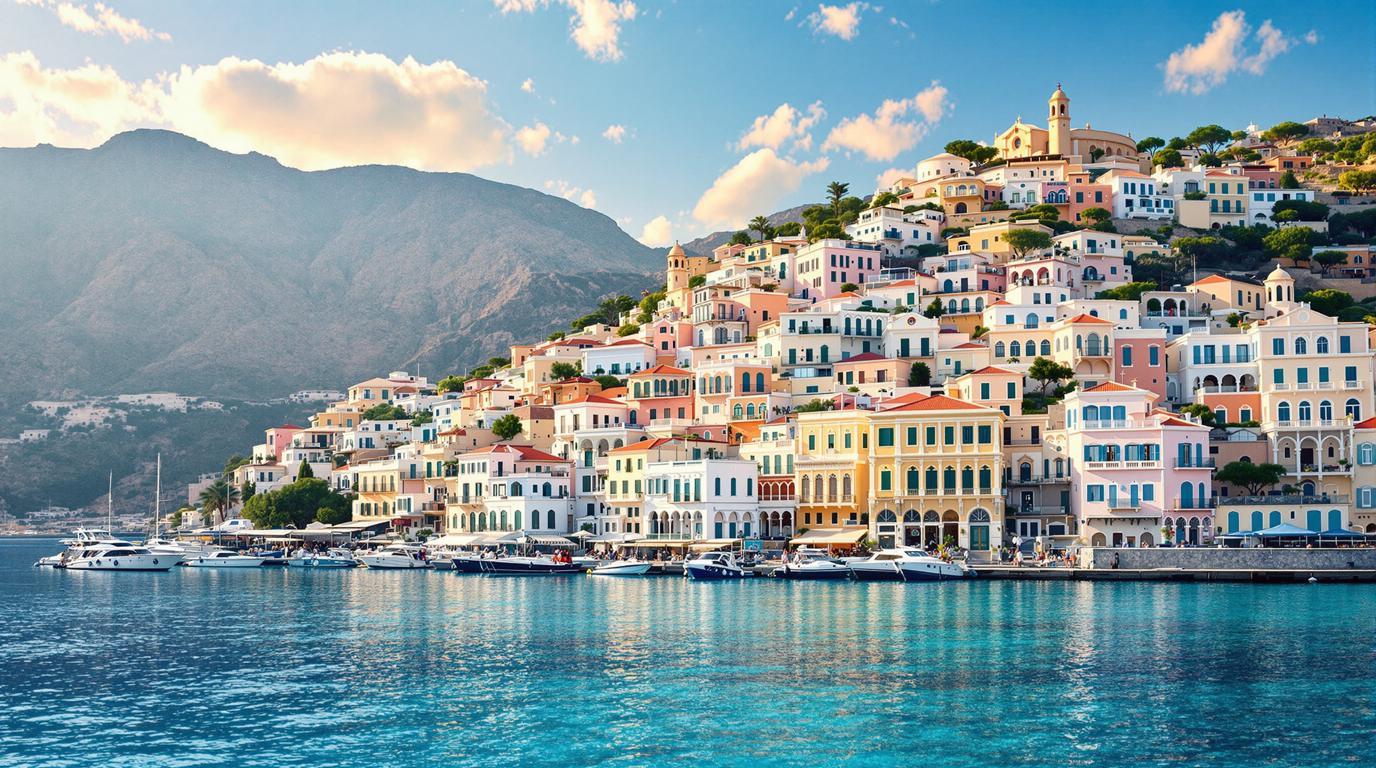Perched in the eastern Mediterranean, Symi Island captivates with its kaleidoscope of neoclassical mansions climbing steep hillsides like a painter’s masterpiece come to life. This tiny Greek haven—just 25 miles from Rhodes—offers something increasingly rare in today’s world: authentic tranquility without sacrificing beauty or culture.
A harbor entrance that stops visitors in their tracks
Arriving by ferry into Gialos Harbor delivers an unforgettable first impression. The amphitheater of pastel-colored 19th-century mansions creates what many consider the most picturesque port in Greece. Captain Andreas, who has piloted boats to Symi for three decades, shares the common reaction:
“I watch visitors’ faces every day. Even the most seasoned travelers fall silent when we round the headland and Symi reveals itself. The cameras come out immediately, but they never capture the feeling.”
The 500-step journey through history
The Kali Strata—a 500-step stone staircase connecting the harbor to Ano Symi (upper town)—serves as both practical infrastructure and living museum. Each twist reveals panoramic views and Venetian architecture that tells the story of when Symi was among the wealthiest Mediterranean trading ports.
Take this climb slowly, not just for breath but to appreciate the craftsmanship of each stone laid centuries ago. The reward awaits in hidden courtyards where artisan workshops continue traditions passed through generations.
275 churches on one small island
Perhaps Symi’s most remarkable feature is its spiritual density—275 churches and monasteries dot this 25-square-mile island. The jewel among them, Panormitis Monastery, dates to the 15th century and houses Byzantine icons of immeasurable cultural value.
Local historian Dimitris Hatzimichalis explains, “Each family historically built their own chapel. It wasn’t vanity but gratitude—often after being spared during storms or illness. Every stone tells a story of faith.”
Crystal waters in dramatic settings
Symi’s beaches exist in their own category of beauty, with Agios Georgios Dysalona standing out for its dramatic cliff backdrop. Accessible only by boat, these secluded coves offer swimming in water so clear it seems an optical illusion.
For a truly hidden experience, hire a water taxi to Marathounda Beach, where dramatic cliff formations create natural caves perfect for exploration.
The shrimp that made an island famous
Gastronomy on Symi revolves around an unlikely star—tiny garidaki symiako shrimp, fried whole and eaten shell-on. This delicacy alone justifies the journey for culinary travelers. Pair it with local wine at tavernas like Tholos or Taverna Meraklis for an authentic taste experience.
Much like certain isolated cultures that preserve ancient traditions, Symi maintains authentic culinary practices largely unchanged for generations.
When to visit for maximum tranquility
While Mediterranean destinations typically surge with tourists in July and August, Symi rewards travelers who arrive in shoulder seasons. May-June or September-October offer perfect weather without crowds, allowing a more intimate experience with locals.
Consider timing your visit with one of the island’s cultural events, where music and art festivals transform historic spaces into living celebrations of Greek heritage.
Where hidden courtyards become luxury accommodations
Accommodations on Symi often occupy lovingly restored mansions, offering a glimpse into the island’s seafaring wealth. The warren-like alleyways of Ano Symi conceal boutique hotels where natural beauty meets understated luxury.
For families or extended stays, consider the tranquil bay of Pedi, where tavernas and peaceful waters create an ideal base for exploration.
Beyond the postcard views
While Symi’s colorful architecture draws initial attention, the island rewards those who venture deeper. Hiking trails lead to the Roukoniotis Lookout and Pedi Valley, where natural landscapes rival the man-made beauty of the harbor.
For history enthusiasts, the island offers extraordinary archaeological connections to ancient civilizations that once dominated the Mediterranean.
“Visitors come for Instagram pictures but leave with something deeper,” observes Maria, a shopkeeper in Gialos. “They find a rhythm of life we’ve preserved here—something becoming rare even in Greece.”
Symi doesn’t demand attention like its famous neighbors. Instead, it offers a gentle invitation to experience Greece as it once was—authentic, unrushed, and stunningly beautiful. Those who accept discover not just a destination, but a perspective worth carrying home.
